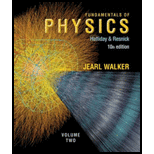
Concept explainers
To find:
a) Whether the momentum of A is less than, equal to, or greater than that of B.
b) Whether the wavelength of A is less than, equal to, or greater than that of B.
Answer to Problem 1Q
Solution:
a) The momentum of A is greater than that of B.
b) The wavelength of A is less than that of B.
Explanation of Solution
1) Concept:
We can write the formula for energy of photon in terms of momentum. From this, we can get the relation between momentum of A and B. From this, we can predict whether the momentum of A is less than, equal to, or greater than that of B. Then we can write the relation between energy and wavelength of photon. From this, we can predict whether the momentum of A is less than, equal to, or greater than that of B.
2) Formulae:
i)
ii)
3) Given:
4) Calculations:
a) The relation between energy and momentum of photon is
From this, we can interpret that
Since
Then,
From this, we can conclude that
b) The relation between energy of photon and its wavelength is
From this, we can interpret that
Since
Then,
From this, we can conclude that
Conclusion:
Energy is directly proportional to momentum and inversely proportional to wavelength.
Want to see more full solutions like this?
Chapter 38 Solutions
Fundamentals of Physics
- An object is placed 24.1 cm to the left of a diverging lens (f = -6.51 cm). A concave mirror (f= 14.8 cm) is placed 30.2 cm to the right of the lens to form an image of the first image formed by the lens. Find the final image distance, measured relative to the mirror. (b) Is the final image real or virtual? (c) Is the final image upright or inverted with respect to the original object?arrow_forwardConcept Simulation 26.4 provides the option of exploring the ray diagram that applies to this problem. The distance between an object and its image formed by a diverging lens is 5.90 cm. The focal length of the lens is -2.60 cm. Find (a) the image distance and (b) the object distance.arrow_forwardPls help ASAParrow_forward
 Principles of Physics: A Calculus-Based TextPhysicsISBN:9781133104261Author:Raymond A. Serway, John W. JewettPublisher:Cengage Learning
Principles of Physics: A Calculus-Based TextPhysicsISBN:9781133104261Author:Raymond A. Serway, John W. JewettPublisher:Cengage Learning Physics for Scientists and Engineers with Modern ...PhysicsISBN:9781337553292Author:Raymond A. Serway, John W. JewettPublisher:Cengage Learning
Physics for Scientists and Engineers with Modern ...PhysicsISBN:9781337553292Author:Raymond A. Serway, John W. JewettPublisher:Cengage Learning Modern PhysicsPhysicsISBN:9781111794378Author:Raymond A. Serway, Clement J. Moses, Curt A. MoyerPublisher:Cengage Learning
Modern PhysicsPhysicsISBN:9781111794378Author:Raymond A. Serway, Clement J. Moses, Curt A. MoyerPublisher:Cengage Learning University Physics Volume 3PhysicsISBN:9781938168185Author:William Moebs, Jeff SannyPublisher:OpenStax
University Physics Volume 3PhysicsISBN:9781938168185Author:William Moebs, Jeff SannyPublisher:OpenStax College PhysicsPhysicsISBN:9781305952300Author:Raymond A. Serway, Chris VuillePublisher:Cengage Learning
College PhysicsPhysicsISBN:9781305952300Author:Raymond A. Serway, Chris VuillePublisher:Cengage Learning College PhysicsPhysicsISBN:9781285737027Author:Raymond A. Serway, Chris VuillePublisher:Cengage Learning
College PhysicsPhysicsISBN:9781285737027Author:Raymond A. Serway, Chris VuillePublisher:Cengage Learning





